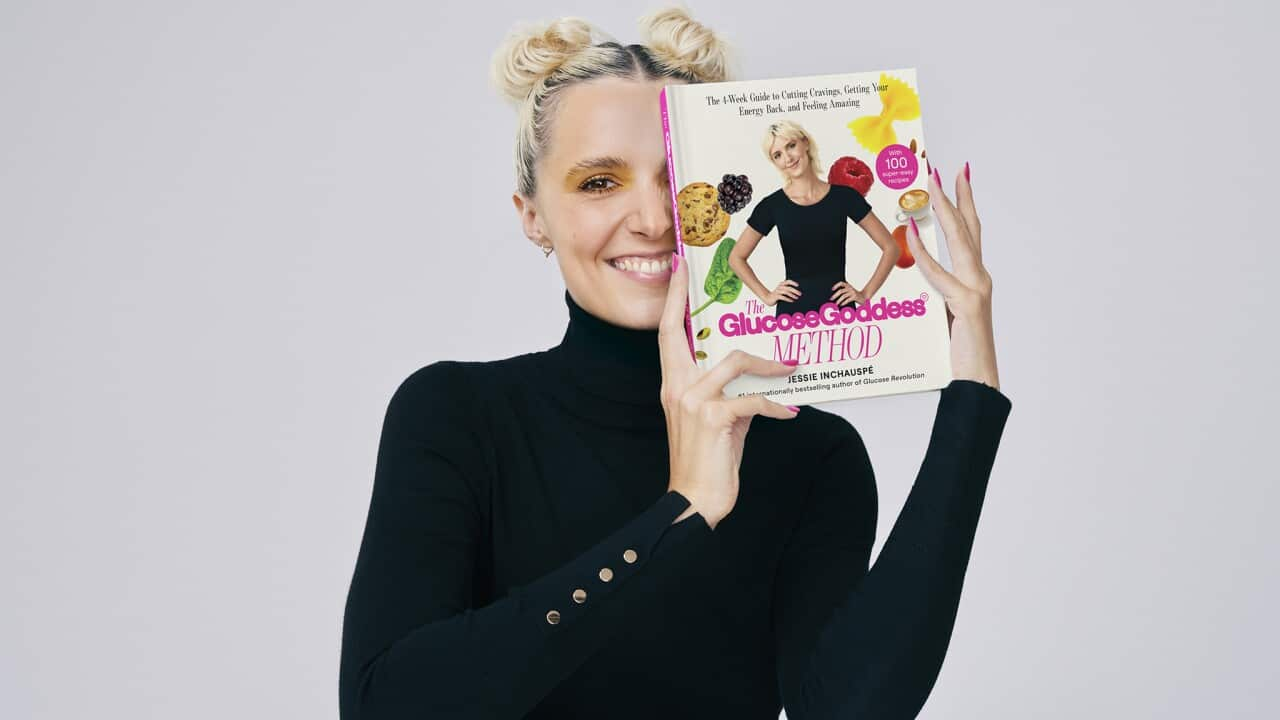After a life-changing injury at 19 years old, Jessie Inchauspé’s journey to recovery led her to biochemistry and working in genetics in Silicon Valley. There, she made a surprising discovery that would transform her into the ‘’ – managing glucose levels isn't just for people with diabetes, it’s crucial for everyone's health and well-being.
Through her books and popular Instagram account – with over five million followers – Inchauspé empowers people to improve their energy, mood, and long-term health without giving up their .
So, what are some of the most important Glucose Goddess hacks? As Inchauspé demonstrates through scientific research and practical experiments, it's not just about what we eat, but how we eat it that makes all the difference.

Credit: Supplied
In this extract, we reveal three of her most transformative, and easy-to-follow tips for anyone seeking to feel better, plus a bonus tip to start your day right. But first, let's talk about the importance of managing our glucose levels.
Why glucose is so important
We know how we want to feel. We want to wake up with a smile, feeling energised and excited for the day. We want to have a skip in our step, feel pain free. We want to spend quality time with our loved ones, feeling positive and grateful. But it can be challenging to know how to get there. We’re overwhelmed by all the buttons. What to do? Where to start?
We should start with glucose. Why? Because it’s the lever in the cockpit with the biggest bang for its buck. It’s the easiest to learn about (thanks to continuous glucose monitors), it affects how we feel instantaneously (because it influences our hunger and mood), and many things fall into place once we get it under control.
Hack #1: Eat foods in the right order
So often, we focus on what and what not to eat. But what about how to eat? It turns out that how we eat our food has a powerful effect on our glucose curves.
Two meals consisting of the same foods (and therefore the same nutrients and the same calories) can have vastly different impacts on our body depending on how their components are eaten.
What is the right order? It’s fibre first, protein and fat second, starches and sugars last.
According to the researchers, the effect of this sequencing is comparable to the effects of diabetes medications that are prescribed to lower glucose spikes.
The explanation for this surprising effect has to do with how our digestive system works. In order to visualise it, think of your stomach as a sink and your small intestine as the pipe below it.
Anything you eat lands in your sink, then flows through to your pipe, where it is broken down and absorbed into your bloodstream. Every minute, on average, about three calories’ worth of food trickle through from sink to pipe. (This process is called gastric emptying.)
If starches or sugars are the first thing to hit your stomach, they get to your small intestine very quickly. There, they are broken down into glucose molecules, which then make it through to the bloodstream very quickly. That creates a glucose spike.
However, consuming the veggies first and the carbs second significantly changes what happens.
Begin by munching on the broccoli. Broccoli is a vegetable, and vegetables contain plenty of fibre. As we’ve seen, fibre isn’t broken down into glucose by our digestive system. Instead, it goes through from sink to pipe to… sewage, slowly and unchanged. But that’s not all.
Fibre has three superpowers: first, it reduces the action of alpha-amylase, the enzyme that breaks starch down into glucose molecules. Second, it slows down gastric emptying: when fibre is present, food trickles from sink to pipe more slowly. Finally, it creates a viscous mesh in the small intestine; this mesh makes it harder for glucose to make it through to the bloodstream. Through these mechanisms, fibre slows down the breakdown and absorption of any glucose that lands in the sink after it; the result is that fibre flattens our glucose curves.
Any starch or sugar that we eat after fibre will have a reduced effect on our body. We’ll get the same pleasure from eating it but with fewer consequences.

Credit: Supplied
Foods containing fat also slow down gastric emptying, so eating them before rather than after carbs also helps flatten our glucose curves.
Consuming the veggies first and the carbs second significantly changes what happens.
The takeaway? Eating carbs after everything else is the best move.
We can eat exactly the same thing – but by eating carbs last, we make a big difference in our physical and mental well-being. What’s more, when we eat foods in the right order, our pancreas produces less insulin and less insulin helps us return to fat-burning mode more quickly, the results of which include losing weight.
Hack #2: Reach for vinegar before you eat
The recipe is simple, but the impact is strong. A drink consisting of a tablespoon of vinegar in a tall glass of water, drunk a few minutes before eating something sweet, flattens the ensuing glucose and insulin spikes. With that, cravings are curbed, hunger is tamed and more fat is burned.
Though people have been drinking vinegar for centuries, it’s only recently that scientists have been able to understand the mechanisms behind its health benefits.
In the past decade, a couple of dozen research teams around the globe have measured the effects of vinegar on our body. Here is how most of the studies went: put together a group of 30 to a few hundred participants. Ask half the group to drink one or two tablespoons of vinegar in a tall glass of water before their meals for three months and give the other group a placebo, something that tastes like vinegar but isn’t vinegar.
What researchers found was that by adding vinegar before meals for three months, the subjects lost 2 to 4 pounds and reduced their visceral fat, waist and hip measurements and triglyceride levels. In one study, both groups were put on a strict weight loss diet, and the vinegar group lost twice as much weight (5 versus 2.25 kilograms), even though they ate the same number of calories as the non-vinegar group.
Here’s what happened in all these participants’ bodies: when they drank vinegar before eating a meal rich in carbohydrates, the glucose spike from that meal was reduced by 8 to 30 per cent.
This hack works for both sweet and starchy foods. Maybe you’re ready to dig into a big bowl of pasta. Or maybe you’re at a birthday party and you must have chocolate cake in the middle of the afternoon. Reach for vinegar first to counter some of the side effects of a glucose spike.
Hack #3: After you eat, move
There are multiple traditions that recommend walking after eating and they exist for good reason. As soon as the influx of glucose (from a large bowl of rice, for example) hits our body, two things can happen. If we stay sedentary as the spike reaches its peak, glucose floods our cells and overwhelms our mitochondria (the powerhouses that are responsible for turning glucose into energy). Potentially dangerous molecules are produced, inflammation increases and excess glucose is stored away in the liver, muscles and fat.
If, on the other hand, we contract our muscles as the glucose moves from our intestine to our bloodstream, our mitochondria have a higher burning capacity. They aren’t overwhelmed as quickly – they are thrilled to use the extra glucose to make energy to fuel our working muscles. On a continuous glucose monitor graph, the difference is stark.
If you want to hit the gym after meals, that’s going to help even more – although some people find strenuous exercise on a full stomach quite hard. The good news is, you can work out at any time up to 70 minutes after the end of your meal to curb a glucose spike; 70 minutes is around the time when that spike reaches its peak, so using your muscles before that is ideal. You can also use your muscles acutely in a push-up, a squat, a plank, or any weight-lifting exercise. Resistance exercise (weight-lifting) has been shown to decrease the glucose spike by up to 30 per cent and the size of further spikes over the following 24 hours by 35 per cent. It’s rare that you’ll be able to curb the entire glucose spike, but you can make a sizeable dent in it.
Bonus Glucose Goddess hack: Eat a savoury breakfast
"Because of the way we eat today, early-morning spikes seem to be the norm," explains Inchauspé. “Whether it's cereal, toast and jam, croissants, granola… fruit smoothies, acai bowls, or banana bread, the typical breakfast in Western countries is composed of mostly sugar and starch – a ton of glucose and fructose”.
The best thing you can do to flatten your glucose curves is to eat a , she continues – “An ideal breakfast for steady glucose levels contains a good amount of protein, fibre, fat and optional starch and fruit (ideally, eaten last). If you're buying breakfast at a coffee shop, get avocado on toast, an egg muffin, or a ham and cheese sandwich, not a chocolate croissant or toast and jam."
Incorporating these Glucose Goddess hacks into your daily routine can help transform your health and well-being. As Inchauspé reminds us, “The goal isn’t perfection – it’s about making small, sustainable changes that have a big impact.”
This is an edited extract from by Jessie Inchauspé (Penguin Random House, RRP $34.99).








